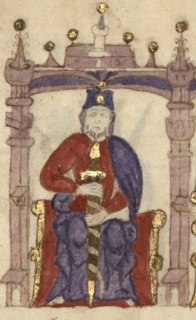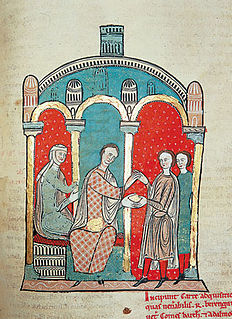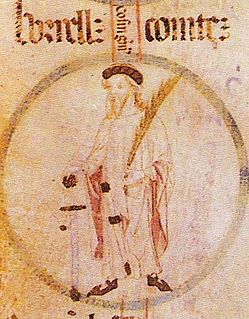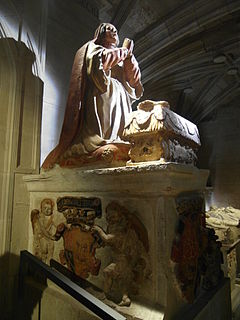
The Cathedral of the Holy Cross and Saint Eulalia, also known as Barcelona Cathedral, is the Gothic cathedral and seat of the Archbishop of Barcelona, Catalonia, Spain. The cathedral was constructed from the thirteenth to fifteenth centuries, with the principal work done in the fourteenth century. The cloister, which encloses the Well of the Geese, was completed in 1448. In the late nineteenth century, the neo-Gothic façade was constructed over the nondescript exterior that was common to Catalan churches. The roof is notable for its gargoyles, featuring a wide range of animals, both domestic and mythical.

Martin the Humane, also called the Elder and the Ecclesiastic, was King of Aragon, Valencia, Sardinia and Corsica and Count of Barcelona from 1396 and King of Sicily from 1409. He failed to secure the accession of his illegitimate grandson, Frederic, Count of Luna, and with him the rule of the House of Barcelona came to an end.

James II, called the Just, was the King of Aragon and Valencia and Count of Barcelona from 1291 to 1327. He was also the King of Sicily from 1285 to 1295 and the King of Majorca from 1291 to 1298. From 1297 he was nominally the King of Sardinia and Corsica, but he only acquired the island of Sardinia by conquest in 1324. His full title for the last three decades of his reign was "James, by the grace of God, king of Aragon, Valencia, Sardinia and Corsica, and count of Barcelona".

Henry, Count of Portugal, was the first member of the Capetian House of Burgundy to rule Portugal and the father of the country's first king, Afonso Henriques.

Sancho Garcés VI, called the Wise was King of Navarre from 1150 until his death in 1194. He was the first monarch to officially drop the title of King of Pamplona in favour of King of Navarre, thus changing the designation of his kingdom. Sancho Garcés was responsible for bringing his kingdom into the political orbit of Europe. He was the eldest son of García Ramírez, the Restorer and Margaret of L'Aigle.

Il matrimonio segreto is a dramma giocoso in two acts, music by Domenico Cimarosa, on a libretto by Giovanni Bertati, based on the 1766 play The Clandestine Marriage by George Colman the Elder and David Garrick. It was first performed on 7 February 1792 at the Imperial Hofburg Theatre in Vienna in the presence of Emperor Leopold II.

Almodis de la Marche was a French noble. She was famed for her marriage career, in particularly for her third marriage to Ramon Berenguer I, Count of Barcelona, with whom she committed double bigamy in 1053, for which the Pope had them excommunicated.
García Sánchez I, was the king of Pamplona from 925 until his death in 970. He was the second king of the Jiménez dynasty, succeeding his father when he was merely six years old.
The Spanish royal family consists of King Felipe VI, Queen Letizia, their children, and Felipe's parents, King Juan Carlos I and Queen Sofía. The royal family lives at Zarzuela Palace in Madrid, although their official residence is the Royal Palace of Madrid. The membership of the royal family is defined by royal decree and consists of: the King of Spain, the monarch's spouse, the monarch's parents, and the heir to the Spanish throne.

Borrell II was Count of Barcelona, Girona and Ausona from 945 and Count of Urgell from 948.

Sunyer was count of Barcelona, Girona and Ausona from 911 to 947.
Sancho García, called of the Good Laws, was the count of Castile and Álava from 995 to his death.

Princess María de las Mercedes of Bourbon-Two Sicilies, Infanta of Spain and Countess of Barcelona was the mother of Juan Carlos I, King of Spain from 1975 to 2014, and grandmother of the reigning Spanish King, Felipe VI.

ErmengolII, called the Pilgrim, was the Count of Urgell from 1011 to his death. He was the son of Ermengol I, Count of Urgell and one of his wives. He was a child when he succeeded his father and was put under the regency of his uncle Ramon Borrell, Count of Barcelona until 1018. Ermengol went on a pilgrimage to the Holy Land and died in 1038 at Jerusalem.

Infanta Maria Cristina of Spain, Countess Marone was the fifth child and younger daughter of Alfonso XIII of Spain and Victoria Eugenie of Battenberg and paternal aunt of King Juan Carlos I.

Doña Jimena Díaz was the wife of El Cid, whom she married between July 1074 and 12 May 1076, and her husband's successor as ruler of Valencia from 1099 to 1102. The spelling Jimena is a modern Spanish one. In the documents of her time, her name was spelled Ximena and it was then pronounced like “Shimena.”
Artau I was the Count of Pallars Sobirà from 1049 until his death in or around 1081.{{efn|Artaus sometimes referred to himself as "margrave", as in comes et marchio in a charter of 1059. His reign was characterised by ceaseless wars and litigations with his more powerful cousin and neighbour Raymond IV of Pallars Jussà.

Martha of Armagnac was the youngest child of John I, Count of Armagnac, and his second wife Beatrice of Clermont. She was the first wife of John I of Aragon but never became Queen of Aragon because she was outlived by her father-in-law Peter IV of Aragon.

Stephanie or Estefania was the Queen consort of Navarre by marriage to García Sánchez III of Navarre. Early chroniclers are in conflict over her parentage.
Maud of Apulia was a member of the Norman D’Hauteville family and a daughter of Robert Guiscard and his second wife Sikelgaita, a Lombard princess, the daughter of Guaimar IV, Prince of Salerno. She was also known as Mahalda, Mahault, Mafalda and Matilda. She was the wife of Ramón Berenguer II, and thus Countess of Barcelona (1078–1082). After her husband’s death, she remarried Aimery I, the Viscount of Narbonne (1086–1108).














